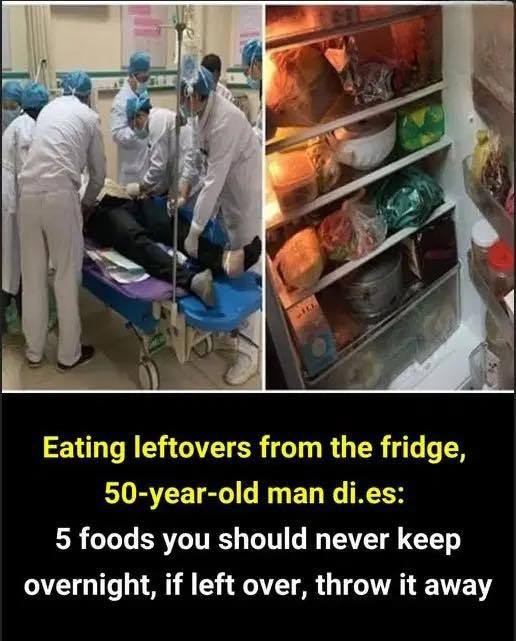We all love leftovers, right? That delicious convenience of a ready-made meal waiting for you in the fridge. It’s a lifesaver on busy days! But here’s a chilling truth: not all leftovers are created equal. While many dishes can be safely stored and enjoyed the next day, certain foods are ticking time bombs, especially prone to rapid spoilage, chemical changes, or dangerous bacterial growth. Ignoring these silent threats could lead to more than just an upset stomach – we’re talking about serious, even life-threatening, food poisoning.
So, before you tuck that plate into the fridge, let’s peel back the layers on which items are better eaten fresh and why they’re best avoided after sitting overnight. Your health (and gut!) will thank you.
The Unsafe 5: Foods to Handle with Extreme Caution Overnight!
These common culprits are notorious for becoming risky when not consumed immediately or stored perfectly.

Mushrooms & Wood Ear Fungus
Mushrooms, including popular varieties like cremini, shiitake, and the earthy wood ear fungus, are incredibly delicate. They contain complex proteins and can have elevated nitrate levels. When cooked and then left to sit, especially at room temperature, their proteins can rapidly break down. Reheating them can further alter their composition, potentially leading to digestive discomfort, nausea, or even more severe reactions in sensitive individuals.
Why they’re risky: Rapid protein degradation, potential for harmful compound formation.
Pro Tip: If you absolutely must save cooked mushrooms, cool them rapidly (within 1 hour) and refrigerate in a shallow, airtight container. Consume within 12-24 hours MAXIMUM, and reheat thoroughly to steaming hot. But truly, fresh is best!
Leafy Greens
Spinach, kale, lettuce, and other nitrate-rich leafy greens are nutritional powerhouses when fresh. However, when cooked and then left to cool slowly or stored for too long, their natural nitrates can convert into nitrites. While nitrites themselves aren’t inherently bad (they’re in cured meats, for example), in high concentrations, they can be problematic, especially for infants and young children, potentially affecting oxygen transport in the blood. Beyond that, their nutritional value diminishes significantly.
Why they’re risky: Conversion of nitrates to potentially harmful nitrites, rapid nutrient loss.
Pro Tip: Always eat cooked leafy greens immediately. If you have leftovers, cool them very quickly (e.g., by placing the container in an ice bath) and refrigerate immediately. Consume within 12 hours. Avoid reheating them.
Soy-Based Foods
Tofu, soy milk, and other soy-based products are rich in protein and moisture, creating an ideal environment for rapid bacterial growth if not handled meticulously. In rare but serious cases, improperly kept soy foods can support the growth of Clostridium botulinum, the bacterium responsible for botulism – a dangerous and potentially fatal form of food poisoning that attacks the nervous system.
Why they’re risky: High protein and moisture content, risk of Clostridium botulinum growth.
Pro Tip: Always keep soy products strictly refrigerated. Once opened, consume soy milk within 3-5 days. Cooked tofu dishes should be cooled quickly and consumed within 24 hours. When in doubt, discard.
Seafood & Soft-Boiled Eggs
Seafood, especially shellfish, raw fish (sushi/sashimi), and cooked fish, spoils incredibly rapidly due to its delicate protein structure and high moisture content. It can quickly harbor harmful bacteria even under refrigeration. Similarly, soft-boiled, poached, or lightly cooked eggs (where the yolk is still runny) pose a higher risk than fully cooked eggs because they haven’t reached a temperature sufficient to kill all potential bacteria like Salmonella.
Why they’re risky: Rapid bacterial growth, high risk of foodborne illness (e.g., Salmonella, Vibrio).
Pro Tip: Seafood and lightly cooked eggs are best consumed immediately after preparation. If you have cooked seafood leftovers, cool them rapidly and consume within 24 hours. Reheat cooked seafood thoroughly until steaming hot. Avoid reheating soft-boiled eggs.
Cooked Rice & Pasta
This one often surprises people! Cooked rice and pasta can be dangerous if left at room temperature. They contain spores of a bacterium called Bacillus cereus. These spores can survive cooking, and if the rice or pasta is left to cool slowly at room temperature, the spores can germinate and multiply, producing toxins. These toxins can cause severe vomiting and diarrhea, even if you reheat the food later, as the toxins themselves are heat-resistant.
Why they’re risky: Bacillus cereus spores can germinate and produce heat-resistant toxins if left at room temperature.
Pro Tip: Always cool cooked rice and pasta as quickly as possible (ideally within 1 hour) by spreading it out on a shallow tray. Refrigerate immediately and consume within 24 hours. Reheat thoroughly until steaming hot, and only reheat once.
💡 Essential Tips for Safe Leftover Storage: Be a Food Safety Pro!
Knowing which foods are risky is just half the battle. Mastering safe storage techniques is your ultimate defense against foodborne illness.
The “Two-Hour Rule” is GOLD! Always refrigerate perishable foods within two hours of cooking. If the ambient temperature is above 90°F (32°C), make it one hour. This is the critical window to prevent rapid bacterial growth.
Shallow Containers are Your Best Friend: Don’t pack hot food into one deep container. Divide large portions into several shallow containers to allow them to cool down quickly and evenly in the refrigerator.
- Refrigerate Below 4°C (39°F): Ensure your refrigerator temperature is set correctly. Use a thermometer to check!
- Consume Promptly: Aim to eat all leftovers within 3-4 days for most foods. The “unsafe 5” should be consumed even sooner, ideally within 24 hours.
- Reheat Thoroughly (and Only Once!): Always reheat leftovers until they are steaming hot (reaching an internal temperature of 165°F or 74°C). Use a food thermometer if you have one. Avoid reheating food more than once, as repeated heating can compromise both safety and nutritional value.
- Avoid Cross-Contamination: Use separate cutting boards and utensils for raw and cooked foods. Store raw meats on the bottom shelf of your fridge to prevent drips onto other items.
- “When in Doubt, Throw It Out!” If a food looks, smells, or feels suspicious, don’t risk it. It’s better to waste a small amount of food than to get sick. Trust your senses, but remember that many harmful bacteria don’t produce noticeable odors or flavors.
- Label & Date: Get into the habit of labeling your containers with the date you cooked the food. This helps you keep track and avoid guessing.
The Bottom Line: Be Mindful, Stay Healthy!
While not all foods spoil overnight, some are simply not worth the risk. Being mindful of what you save—and how you store it—can help keep your meals safe, healthy, and worry-free. A little knowledge and a few simple habits can make a huge difference in protecting your family from foodborne illness. Eat smart, live well!
What are your go-to food safety tips for leftovers? Share them in the comments below! 👇
#FoodSafety #Leftovers #FoodPoisoning #HealthyEating #KitchenTips #HomeSafety #HealthTips #FoodStorage #CookSmart #PreventIllness #ViralHealth
Beta feature


